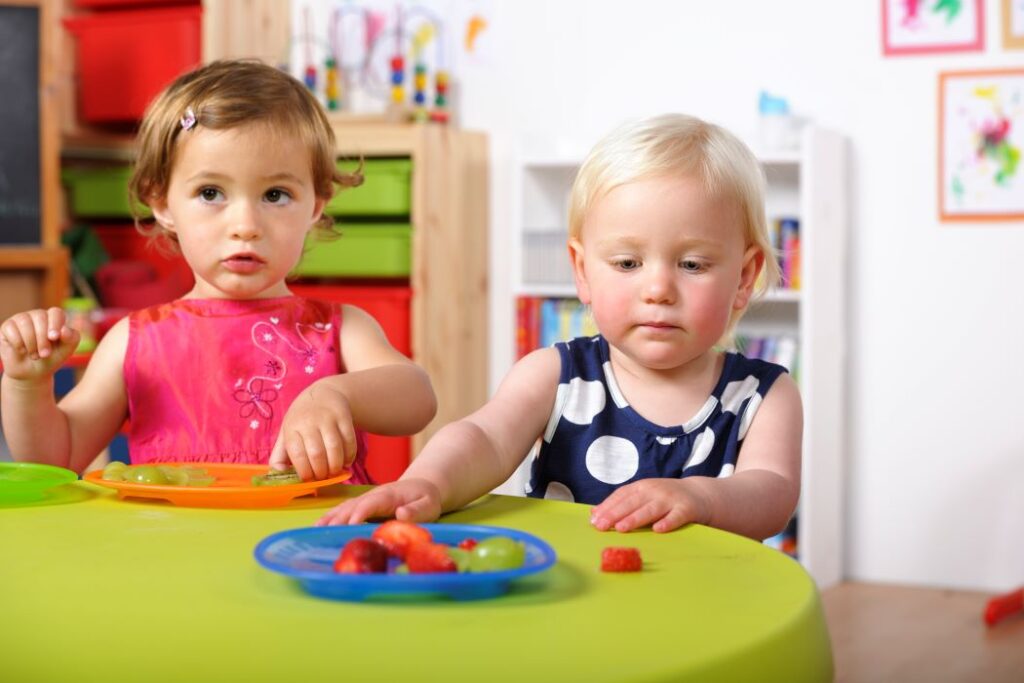Written By: Lauren Ruffrage, MS CCC SLP
 Most of us have heard of IgE-Food Allergies that require an individual to carry an EpiPen, which can lead to anaphylaxis. Many people don’t know that there is another group of Food Allergies called Non-IgE-mediated allergies. With this category of Food Allergy, our immune system believes a certain food is toxic, and tries to get rid of the allergen while it’s still in the digestive tract. This results in symptoms such as nausea, vomiting, and diarrhea among others. With both IgE and Non IgE-mediated Food Allergies, knowing about cross-contact and potential hidden allergens in our early childhood centers, classrooms, and therapy materials is essential.
Most of us have heard of IgE-Food Allergies that require an individual to carry an EpiPen, which can lead to anaphylaxis. Many people don’t know that there is another group of Food Allergies called Non-IgE-mediated allergies. With this category of Food Allergy, our immune system believes a certain food is toxic, and tries to get rid of the allergen while it’s still in the digestive tract. This results in symptoms such as nausea, vomiting, and diarrhea among others. With both IgE and Non IgE-mediated Food Allergies, knowing about cross-contact and potential hidden allergens in our early childhood centers, classrooms, and therapy materials is essential.
Cross-contact occurs when an allergen is accidentally transferred from a food that contains the allergen to one that does not contain it. Here is an example with ice cream. If the ice cream scoop used to scoop dairy ice cream is only rinsed off, or dunked in a bowl of water to rinse, and then used to scoop non-dairy sorbet for a child with a dairy allergy, there could be enough milk protein remaining on the utensil to cause a reaction in the child with the Food Allergy.
How can we prevent cross-contact with proper cleaning? In one study done on the distribution of peanut allergy in the environment, it was found that hand washing with liquid soap, bar soap or using commercial cleaning wipes for surfaces were effective at eliminating food proteins entirely. However, using plain water to rinse, antibacterial hand sanitizer, and dishwashing liquid were all ineffective at consistently eliminating food proteins on surfaces. So…washing hands with soap and water before and after eating is essential to avoid cross-contact! Wiping down surfaces with commercial cleaners and ideally using separate kitchen tools entirely, are ideal ways to avoid cross contact. These practices can help prevent the unintentional transfer of residue or trace amounts of an allergic food into another food.
 What are some Potential sources of accidental exposure for both IgE-mediated and Non IgE-mediated Food Allergies outside of the home? KidsWithFoodAllergies.org shares a downloadable guide to share with other caregivers, schools, camps, and early learning centers. They name many common activities/materials that may contain a food allergen, as well as potentially safe alternatives and appropriate precautions. Here are 5 potential sources of accidental exposure to be aware of as therapists:
What are some Potential sources of accidental exposure for both IgE-mediated and Non IgE-mediated Food Allergies outside of the home? KidsWithFoodAllergies.org shares a downloadable guide to share with other caregivers, schools, camps, and early learning centers. They name many common activities/materials that may contain a food allergen, as well as potentially safe alternatives and appropriate precautions. Here are 5 potential sources of accidental exposure to be aware of as therapists:
- Play-Doh® (commercial or wheat-based homemade) –potential allergen: Wheat
- Crayons – potential allergen: Soy
- Bird feeders— potential allergen: Wheat, Peanut butter, Nuts, Seeds
- Finger paint – potential allergen: Wheat, Milk, Corn, Oat
- Projects using empty egg cartons, milk cartons, beverage cartons, yogurt containers, food jars, etc. — potentially allergen: all top 9
Kids With Food Allergies is an organization dedicated to saving lives and reducing the burden of food allergies through support, advocacy, education, and research. Check out their guide for safe alternatives and many other resources for providers and families. To learn more about Food Allergies and Feeding Therapy, check out my upcoming Summit Live Webinar: Food Allergies and Pediatric Feeding Therapy offered on September 27th, 2024 11am-1pm EST.
Click this link: Potential Food Allergens in Preschool and School Activities, for a free downloadable resource!
CLICK HERE to view Lauren Ruffrage’s Instructor Page.
References:
Chehade M, Meyer R, Beauregard A. Feeding difficulties in children with non-IgE-mediated food allergic gastrointestinal disorders. Ann Allergy Asthma Immunol. 2019 Jun;122(6):603-609. doi: 10.1016/j.anai.2019.03.020. Epub 2019 Mar 26. PMID: 30922955; PMCID: PMC8237234.
Perry, T. T., Conover-Walker, M. K., Pomés, A., Chapman, M. D., & Wood, R. A. (2004). Distribution of Peanut Allergen in the environment. Journal of Allergy and Clinical Immunology, 113(5), 973–976. https://doi.org/10.1016/j.jaci.2004.02.035
Potential food allergens in school crafts & Supplies. Kids with Food Allergies. (2024, January 26). https://kidswithfoodallergies.org/living-with-food-allergies/planning-for-school/potential-food-allergens-in-school-crafts-and-supplies/
Voluntary guidelines for managing food allergies in … (2010). https://www.cdc.gov/healthyschools/foodallergies/pdf/20_316712-A_FA_guide_508tag.pdf
About Summit Professional Education
Summit equips therapists with better continuing education courses that provide CEUs while impacting patient outcomes. Find high-quality on-demand CE along with the largest offering of live options — including live webinars, live streams, and in-person courses. Want to deep dive on a topic? Summit offers hundreds of 6-hour courses for the most in-depth learning!
